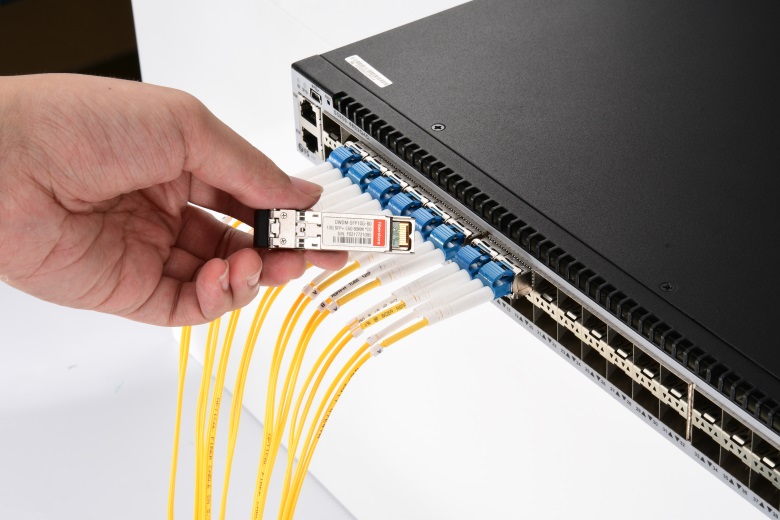An optical transceiver is a compact network component that uses light to transmit and receive digital data over fiber optic cables. With the exponential growth of data and need for high speed transmission, optical transceivers have become increasingly important in telecommunications networks. In this article, we explore the working, technology and different types of optical transceivers.
How do Optical Transceivers Work?
Optical Transceivers contain a laser diode transmitter that converts electrical signals into pulses of light and a photodiode receiver that converts light pulses back into electrical signals. The transmitter modulates the light intensity or wavelength depending on the data being transmitted – a process called amplitude modulation or wavelength division multiplexing.
On the receive side, the photodiode detects changes in light intensity/wavelength and converts it back into an electrical signal. Supporting circuitry ensures signal amplification, timing recovery, and clock synchronization between transmitter and receiver. The transmitted light signal travels through the fiber optic cable at the speed of light while experiencing very low attenuation over long distances.
Types of Optical Transceivers
SFP/SFP+ Transceivers
Small Form-factor Pluggable (SFP) modules are the most common transceiver form factor currently in use across data centers and enterprise networks. SFP modules support data rates up to 10Gbps. The slightly larger SFP+ modules can support up to 12Gbps and are used more commonly in high-speed networks. SFP and SFP+ modules have revolutionized transceiver upgradability by making field installations quick and easy.
QSFP/QSFP28 Transceivers
The Quad Small Form-factor Pluggable (QSFP) transceivers were developed for applications requiring higher density and port counts. QSFP modules support up to 128Gbps of bandwidth over either a single or multiple duplex fiber optic connections. The newer QSFP28 specification doubles the maximum data rate to 256Gbps. QSFP transceivers are becoming increasingly popular in large data centers and high-performance computing.
CFP/CFP2/CFP4 Transceivers
The C form-factor pluggable (CFP) transceivers were designed for extremely high-speed applications like 100GbE and 400GbE. CFP modules support up to 100Gbps, CFP2 up to 200Gbps and the latest CFP4 can go up to 400Gbps. CFP transceivers provide the highest bandwidth density and are commonly used in core networking equipment and long-haul telecommunication systems.
Optical Transceiver Technologies
Multi-Mode vs Single Mode
Early optical networks predominantly used multi-mode fiber and transceivers operating at short distances of up to 550 meters using vertical cavity surface emitting lasers (VCSELs). Now, single-mode components running at longer wavelengths and over distances up to 10km have become mainstream due to reduced attenuation and higher bandwidth potential.
WDM Technology
Wavelength division multiplexing (WDM) enables multiple optical signals of different wavelengths to be transmitted over the same fiber by using thin-film or Bragg grating filters. This significantly increases fiber bandwidth utilization. Dense WDM (DWDM) systems multiplex over 100 channels over a single fiber.
Direct Modulation vs External Modulation
In direct modulation, the transmitter laser intensity is modulated directly by the input electrical signal. External modulation uses a separate modulator driven by the laser, providing better performance over long reaches.tunable lasers are now enabling flexible grid networks.
Changing Landscape of Optical Communication
With 5G deployments, explosive internet traffic, and technologies like AI/ML gaining ground – there is an unprecedented demand for bandwidth. Optical networks employing high-speed transceivers are playing a key role in keeping up with these demands. Transceiver port speeds are growing exponentially with 100G, 400G, and prototype 800G transceivers in development.
Integrated photonic transceivers are also emerging as technology scaling enables miniaturized lasers, modulators, and detectors to be integrated onto a single silicon chip. Advances in coherent detection and digital signal processing ensure better performance over long reaches. Flexible grid networks using software defined optical networking and space-division multiplexing herald a new era of limitless bandwidth through optical fibers. As data transmission needs continue to rise exponentially, optical transceivers will remain crucial for future-proofing our communication infrastructure.
*Note:
1. Source: Coherent Market Insights, Public sources, Desk research
2. We have leveraged AI tools to mine information and compile it



